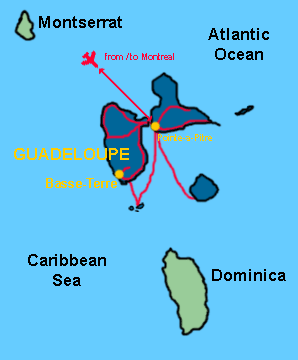 |
full name |
 |
Department of Guadeloupe (part of France) |
| capital |
 |
Basse-Terre |
| population |
 |
0.4 million (as of 2004) |
| surface area |
 |
1700 sq km |
| currency |
 |
euro (€) |
| exchange rate |
 |
US$ 1 = € 0.77 (as of January 2005) |
| language |
 |
French |
| main religion |
 |
95% Roman Catholic |
| Internet users |
 |
14% (as of 2000, all of France) |
 |
We celebrated New Year's Eve 2004 in Montreal, and arrived in Guadeloupe on January 1st, 2005 for the 3-week grand finale of our travel adventure. We returned to Canada on January 23rd, 2005 to spend another night in Montreal before arriving at our starting point, Ottawa, on January 24th, 2005.
Our base in Guadeloupe was Gosier, about 8km southeast of Pointe-à-Pitre, from where we explored four islands of the archipelago:
Grande-Terre and Basse-Terre, the right and left wing of the butterfly shape which constitutes the main part of Guadeloupe;
Les Saintes, an idyllic island group south of Basse-Terre; and
Marie-Galante, the third largest island of Guadeloupe and located to the south of Grande-Terre.
We were generously hosted by old and new friends, and were introduced to the culture of les Antilles. We wined at every lunch and supper, celebrated a champagne-filled birthday party, feasted on high quality home-cooked meals, and got very quickly acquainted with ti-punch (white rum mixed as desired with cane sugar and fresh lime). Yes, Guadeloupe wins hands down in the category "country where we drank the most alcohol".
Guadeloupe's main attraction is certainly its natural beauty and its beaches even though there are a few other attractions worth exploring (if you get tired of the beach or if it is unfortunately raining). Pointe-à-Pitre offers the anti-slavery Musée Schoelcher, the Musée Saint-John Perse, and public markets selling spices, fresh produce, and fresh fish. Gosier has a rather small aquarium. At Morne-à-l'Eau, there is an unusual cemetery with house-like tombs decorated with black and white ceramic tiles. Closer to Basse-Terre, there is the banana, coffee, and vanilla plantation of Vanibel, and at Trois-Rivières, there is the Parc Archéologique des Roches Gravées with interesting petroglyphs in a lush setting.
Almost all beaches on Grande-Terre and Basse-Terre are easily accessible with your own transport and quite developed. On Grande-Terre, the beaches at Sainte-Anne and Saint-François are nice. The beach at Gosier is also good for an afternoon swim. At the Pointe des Châteaux, the easternmost point of Grande-Terre, waves crash against steep limestone cliffs. On Basse-Terre, Plage de Clugny and Grande Anse are good choices, and there is a black sand beach near Trois-Rivières. The hike to the top of the windswept, active volcano of La Soufrière offers views over all of Guadeloupe - but only on the rare day where the top of La Soufrière is not covered in clouds.
Terre-de-Haut, the main island of Les Saintes, boasts a great lookout on top of Le Chameau, a laid back village called Bourg des Saintes, Fort Napoléon, and several great beaches (Plage de Pompierre, Plage du Figuier, Petite Anse du Pain de Sucre, Plage de Crawen). Terre-de-Haut can be leisurely visited on foot or zoomed through on rented motorcycles. Finally, Marie-Galante is a rather rural island, still focused on sugarcane. The beaches are less crowded (Plage de la Feuillère, Petite Anse, Anse Canot), and there is the aptly named hole in the rock Gueule Grand Gouffre. In any case, the distilleries always welcome visitors (Distillerie Bielle, Distillerie Poisson) ...


































